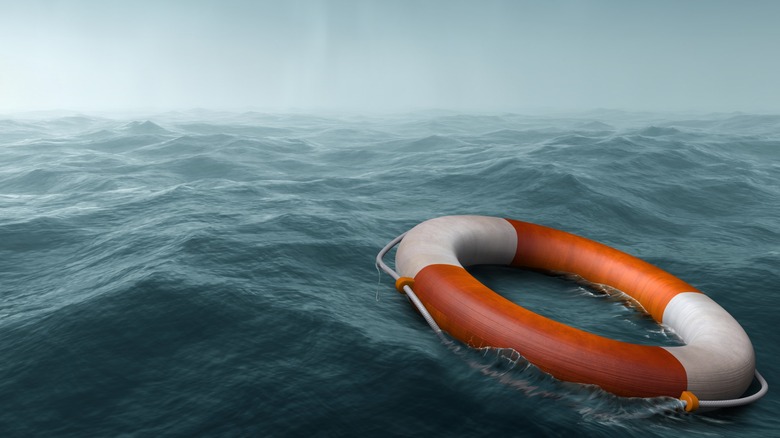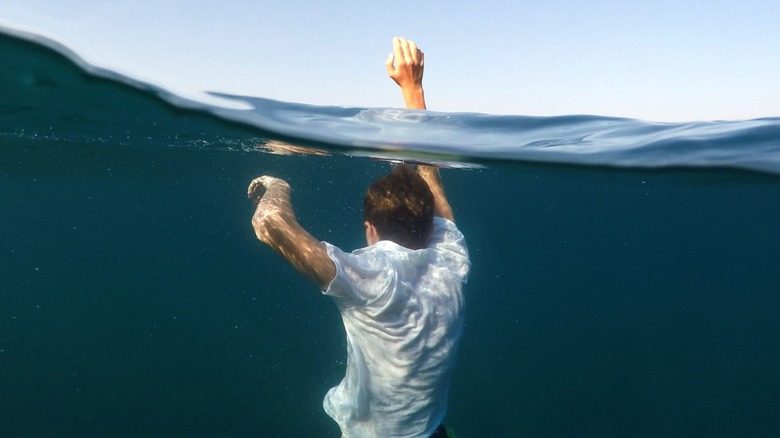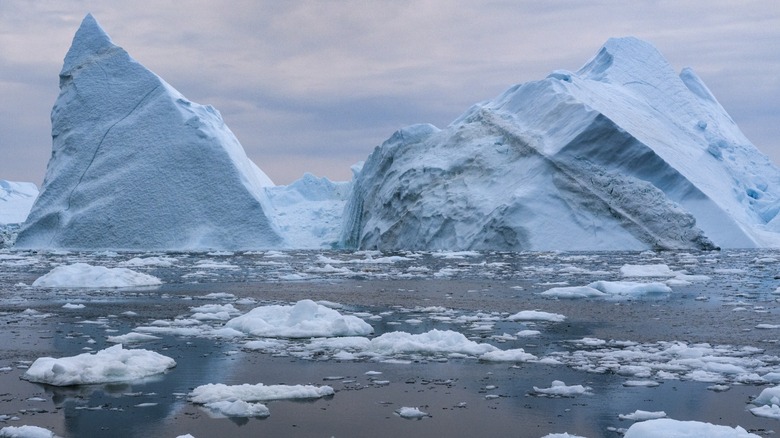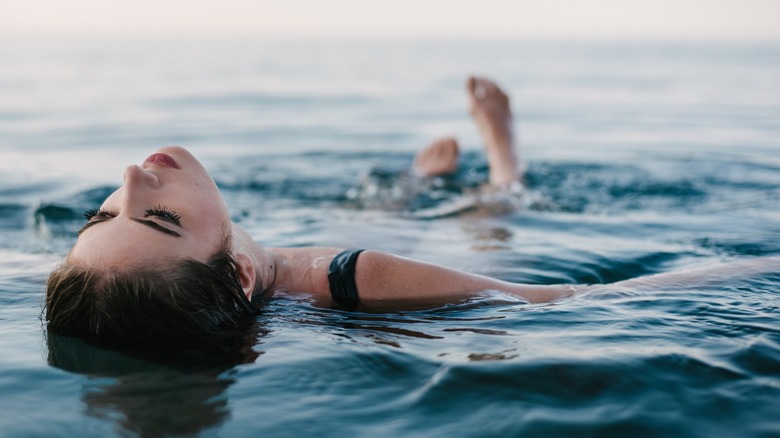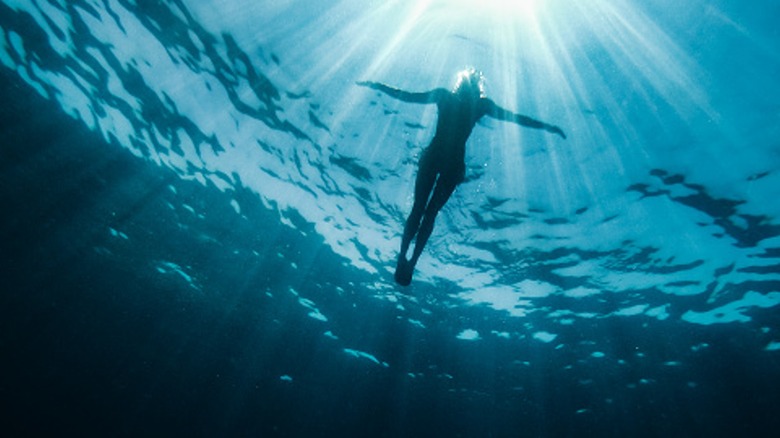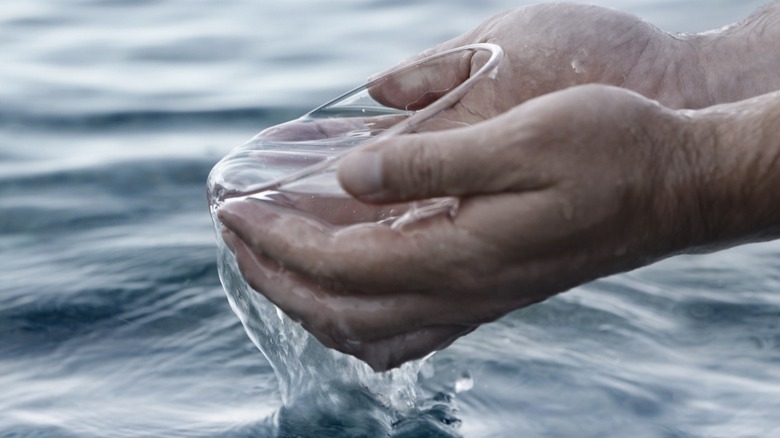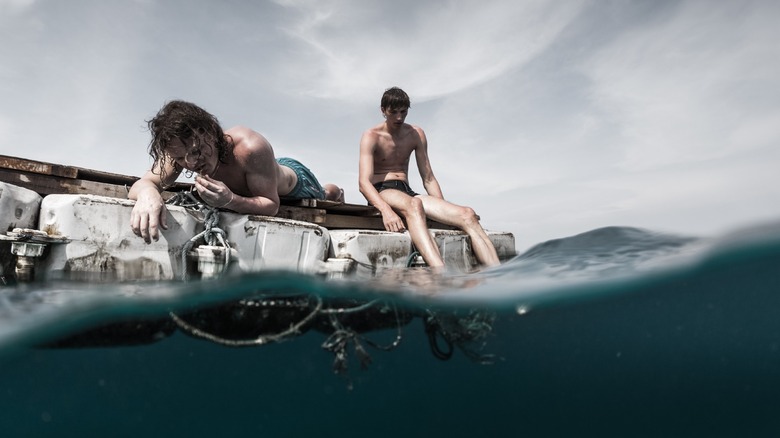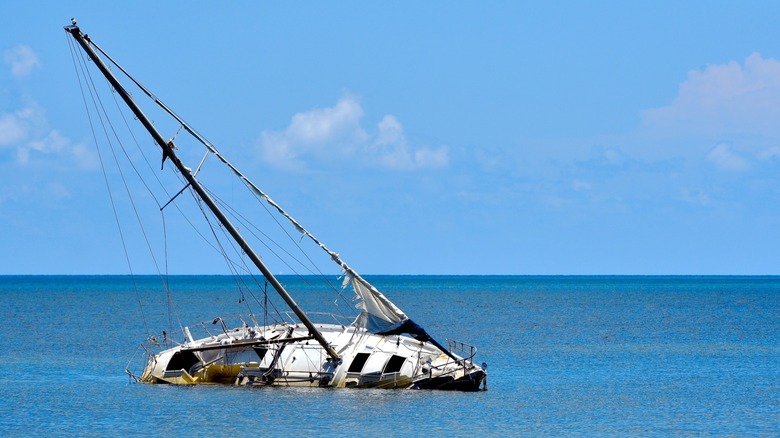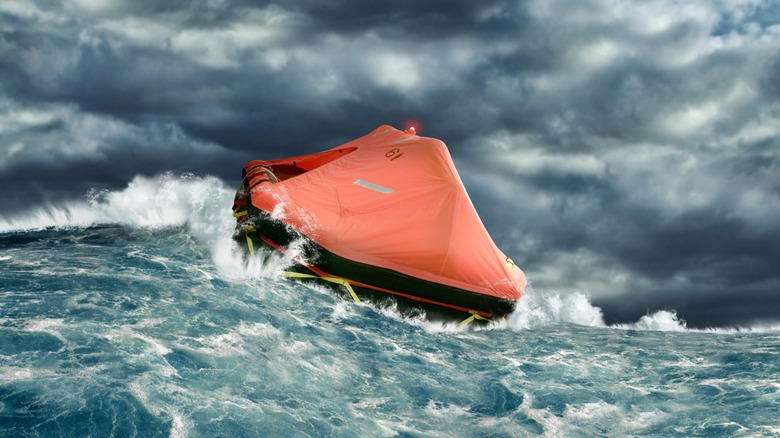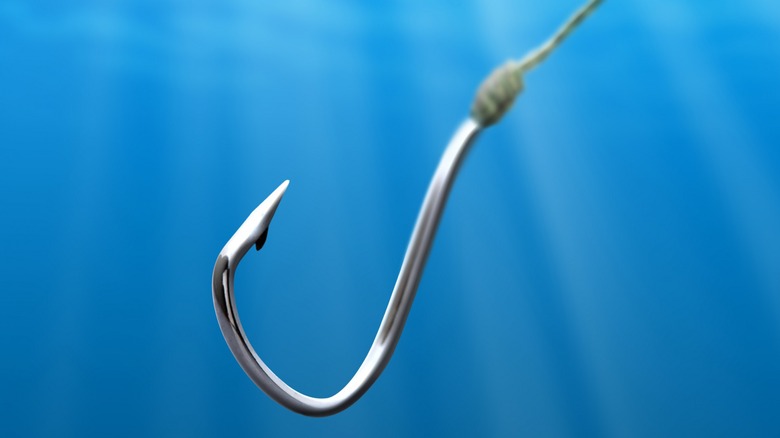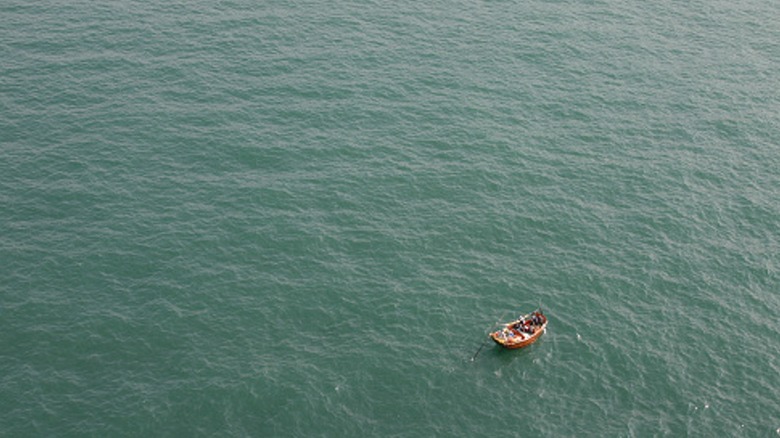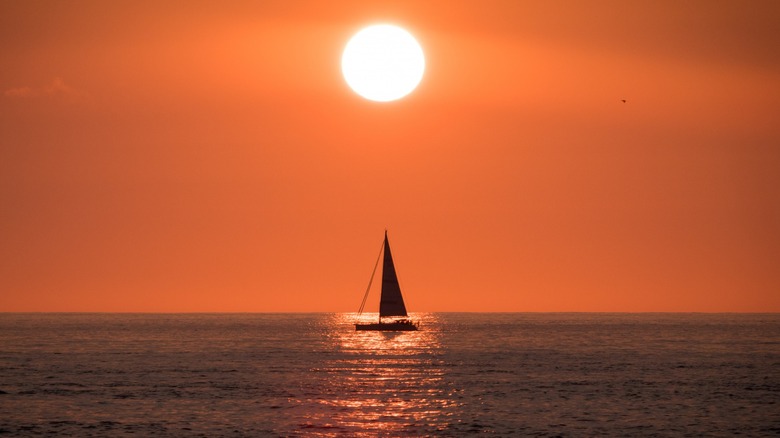How Long Could A Person Potentially Survive Lost At Sea?
For centuries, the sea's siren song has beguiled mankind. And, whether by setting sail upon the ocean breeze, plunging the depths below, fishing for profit, riding warm coastal waves, or simply dipping their toes in the surf, people have continuously answered its summons. But alongside the adventure, abundance, and amusement of maritime exploits has always come the risk of peril. Over the decades, shipwrecks, riptides, dangerous weather, and freak accidents have left countless people adrift on the open ocean — and it's not just a horror reserved for distant history.
Each year, up to 25 people fall off cruise ships, 2,000 fishermen are lost, and tens of thousands of beachgoers are caught in powerful rip currents. Meanwhile, tragic incidents, like the June 2023 foundering of a Greek migrant boat, leave hundreds of people unaccounted for. Given these chilling numbers, the odds are good that, at this very second, someone is floating miles from land, desperately hoping for rescue.
It's disturbingly easy to get lost in the sea's vastness, which covers over 70% of the Earth's surface. What's worse, it's so inhospitable, it might as well be another planet. Being adrift can rob a person of air, water, warmth, food, shelter, sleep, and health — aka every single basic requirement for human survival, according to WebMD – yet some manage to survive the terrifying ordeal. With the July 2023 rescue of Timothy Shaddock, who had been adrift for around three months, many are wondering: How long could a person potentially survive lost at sea?
Only seconds if they give in to panic
For many, being lost at sea only lasts a few seconds. A person who unexpectedly falls into the water without any sort of flotation device, swimming abilities, or awareness of water safety techniques is automatically at a greater risk of drowning, but even skilled swimmers can drown if they give in to fear. A panicked person behaves irrationally and impulsively — and, unfortunately, there's no margin for error in the ocean.
According to WebMD, a panicking person may thrash wildly, yell, and desperately gulp air or shut down entirely, tilting their head back and bobbing silently up and down until they eventually submerge in what lifeguards call the "instinctive drowning response." As Mayo Clinic notes, panic also causes shortness of breath, which makes breathing seem harder in general. What's worse, intense fear can even cause a person to faint. In all cases, panicking in the water quickly becomes a deadly positive feedback loop.
As a person sinks deeper, they become unable to reliably inhale air, which leads to greater panic. Since the average person can only hold their breath for about one minute, they inevitably start inhaling water instead. Drowning then occurs in seconds to minutes as water fills the lungs. In the absence of a rescuer who can immediately administer CPR, it's fatal. "Once the panic sets in, everything changes," Ocean City Beach Patrol member Lt. Ronald Kirk told WHYY. "If you panic, it could be doomsday. You don't think straight anymore."
Just minutes in very cold water
Even with a cool head and strong water skills, a person is no match for cold water. And, unfortunately, cold water – technically anything below 70 degrees Fahrenheit – makes up a pretty significant percentage of the world's oceans. According to NASA's Earth Observatory, the sea's surface temperature ranges from 28 degrees Fahrenheit to 95 degrees Fahrenheit, meaning where exactly a person becomes lost at sea often determines how long they can live.
Water robs a person of body heat much faster than air, making it easy to develop hypothermia. But that's not the only concern. According to a 2003 article published in The Lancet, the "cold shock response" occurs when the skin cools so fast that the body can't keep up, resulting in uncontrollable gasping, hyperventilation, and heart strain. The reaction typically subsides in minutes, but that's usually far too late for those who have drowned or suffered cardiac arrest.
When the Titanic sank in 28-degree Fahrenheit water, cold shock and hypothermia killed hundreds. As survivor John Thayer recalled (via Michael Davie's book "Titanic"): "The cries of the drowning floating across the quiet sea filled us with stupefaction... It sounded like locusts on a midsummer night, in the woods of Pennsylvania. This terrible continuing cry lasted for twenty or thirty minutes, gradually dying away, as one after another could no longer withstand the cold and exposure. Practically no one was drowned, as no water was found in the lungs of those later recovered. Everyone had on a life preserver."
Hours with nothing but a few basic water survival skills
Surviving in open water with nothing but your wits is possible with a few basic survival techniques. Even without flotation, a person who can remain relatively calm, float on their back, hold their breath, and tread water can keep from drowning — hopefully long enough to be rescued. Sea conditions – such as stormy weather, choppy surf, and water temperature — determine which tactics work best.
As Frances and Michael Howorth note in "The Sea Survival Manual," hypothermia, which becomes lethal in minutes to hours, can be staved off if you're wearing a life jacket by employing the Heat Escape Lessening Posture (H.E.L.P.) in which the knees are tucked to the chest and held there to trap as much body heat as possible. Staying still actually helps more than moving around, as the body naturally transfers blood away from the extremities to conserve heat. Resting by floating on the back is helpful in calm conditions, while floating face first offers more protection from wind and waves in rough seas.
These skills have saved many lives over the years. In 2018, Kay Longstaff fell off the back of a cruise ship 50 miles from Croatia. She drifted for 10 hours before rescuers found her, surviving by floating on her back and singing to distract herself from the cold. Then, in 2021, an unnamed man was swept miles out to sea while swimming off Maui's coast. He drifted for eight hours, staying afloat by continuously treading water. Neither had a life jacket.
Up to three days in warmer water without any flotation
Getting lost at sea in warm tropical waters is ideal, especially in the absence of a flotation device. In water 70 degrees Fahrenheit or warmer, hypothermia is much less of a concern (though, as Florida doctor Andrew Schmidt explained to News4Jax, it's technically a constant risk in any water below 94 degrees Fahrenheit). Still, a person can only stay afloat for so long before the negative effects of dehydration, exhaustion, and low blood sugar start impacting their ability to stay aware and conscious – a state that quickly becomes deadly at sea. The world record for treading water is 85 hours, though the average person can only keep it up for two to three hours at a time (eight hours or more if they're fit).
But, with survival at stake, adrenaline often helps out. In January of 1998, Tom and Eileen Lonergan were accidentally left at sea during a dive on Australia's Great Barrier Reef. Though the couple was tragically never found, a recovered dive slate featuring a handwritten note indicated that they survived at least one full day adrift with nothing but their dive gear. And, after falling off a boat into the Indian Ocean during a storm in April of 2013, Brett Archibald treaded water for 28.5 hours before being rescued, though he suffered severe cramps and hallucinations, had battled gulls, jellyfish, and a shark, and was reportedly only an hour from death when he was finally pulled from the water.
A few more days with water and nothing else
Ironically, a lack of water is one of the biggest threats to survival when lost at sea. In theory, a person could go overboard wearing a CamelBak, holding a Hydro Flask, or, better yet, having somehow managed to snag a water tank from their ship's wreckage. Supposing they retained and rationed it, they could feasibly buy at least a few more days, hydrating themselves while staying afloat and giving rescuers additional time to find them.
Of course, this is unlikely and conditions would have to be just right for it to work. In addition to water, a person would also need strong swimming skills, good health, and favorable ocean conditions. Being immersed in seawater also rapidly dehydrates the body, and additional water is needed to offset the effects. As NOAA notes, it is for this reason that drinking seawater is inadvisable and potentially deadly, as the body must use its precious internal supply of fresh water to flush out the excess salt.
According to Frances and Michael Howorth in their book "The Sea Survival Manual," the human body requires a daily minimum of 0.5 liters of fresh water in cool conditions and 1 liter in warm conditions. Unfortunately, a 1993 report published by the National Academies Press notes that a shocking 3 to 4 liters can be lost each hour during physical exertion, making staying hydrated at sea a losing battle. Conserving energy as much as possible is key.
Three to 11 days with just flotation
As we learned from Jack and Rose in James Cameron's epic film "Titanic," having a flotation device of any kind, whether it be a life jacket, piece of debris, life raft, or capsized boat, can greatly improve your odds of survival on the open ocean. Being able to rest out of the water eliminates the dangers of cold shock, slows the rate of body heat loss, and relieves the need for constant exertion, allowing for energy conservation.
Under such dire circumstances, pretty much anything can function as a flotation device. A man named Ivan survived 18 hours adrift using a partially deflated toy ball to keep his head above water after he was swept out to sea by a strong current off the coast of Greece in 2022. And, after his boat sank in Brazilian waters later that same year, fisherman Romualdo Macedo Rodrigues survived for 11 days using a large cooler as a makeshift life raft. "That freezer was God in my life," he told CNN. "The only thing I had was the freezer. It was a miracle."
Still, the human body can't survive long without water. While the exact number of days a person can go without hydration depends on the individual and how much they are sweating, Medical News Today notes that, for the average person, it's only about three to four days. In an interview with National Geographic, medical professor Claude Piantadosi referred to this limited timeframe as "the hundred-hour rule."
Weeks to months with a proper vessel and adequate water
With flotation and water, a person lost at sea has much better odds. And, with a proper vessel like a life raft or incapacitated boat, they have even more options. A dry surface alleviates the more immediate risks of hypothermia, drowning, and shark attacks, and makes resting possible. Plus, scavenged materials on the vessel can be MacGyver-ed into all sorts of useful tools, including those used to collect water.
For example, when a storm pushed Dominica native Elvis Francois out to sea on a broken sailboat in early 2023, all he had to work with was some extra clothing (which he used to harvest rainwater), spices, and a bottle of ketchup — but he made it last for the 24 days it took to get rescued. And, when Tami Oldham Ashcraft became lost at sea after a Category 4 hurricane rendered her sailboat mostly inoperable in October of 1983, she miraculously survived 41 days adrift, using a single tattered sail, meager rations, and a sextant to navigate all the way to Hawaii.
If you're wondering how any of this is possible, it's because the average person can survive a remarkably long time — one to three months, per Medical News Today – without food. "A lack of water will kill you after several days, but it takes a whole month to starve," sea survivor Steven Callahan told Cracked. "You won't live long enough to suffer the unthinkable agonies of starvation unless you're lucky."
Those who are educated about marine life likely survive longer
Knowing about marine life can benefit a person lost at sea, starting with their first few minutes in the water. Simple things like avoiding injuries, thrashing, and creating unnecessary noise, which attracts sharks, and steering clear of venomous creatures such as box jellyfish and siphonophores, which can cause fatal reactions, can prolong a free-floating person's life.
Sharks often bump or test-bite objects in the water before striking, so knowing how to discourage an all-out attack is essential. As Frances and Michael Howorth explain in "The Sea Survival Manual," splashing, yelling, and kicking the eyes and gills are often enough of a deterrent. Luan Nguyen, who spent 28 hours adrift in 2022, put this advice to the test. It saved his life. "The shark hit the life vest, and I tried to push him off," he told Today. "He wouldn't go away so I jabbed him in his eyes... I put my thumbs in his eyes, and he took off."
Natural knowledge can also contribute to effective hunting, fishing, and food harvesting strategies. For Steven Callahan, who spent 76 days adrift in the Atlantic Ocean, the creatures proliferating near his raft were a literal lifesaver. "The fish fed me, almost killed me (by ripping a gash in my raft), and ultimately saved me by attracting birds, which lured fishermen," he told Cracked. "This little mini-ecosystem that formed around my raft island led civilization to find me again, and wound up saving my life."
Several months with food, water, and a sturdy vessel
A person with a decent vessel, some shelter from the sun and elements, and fairly regular access to both food and water can survive for quite a while so long as their craft stays afloat. What's more, many modern life rafts come equipped with emergency supplies, cover, and modest food and water rations, making longer-term survival more likely than it's ever been. Indeed, many individuals have survived months with just such a setup.
Most recently, the world rejoiced at the rescue of Timothy Shaddock and his dog, Bella, in July of 2023 after the two had been lost at sea for three months. Ultimately, his survival was made possible by his catamaran, which had lost its electronics in a storm but remained afloat. Shaddock made do with the provisions he had on board, supplementing his (and Bella's) diet with raw fish he caught.
Similarly, Chinese sailor Poon Lim, who was the lone survivor of a German attack on his ship during World War II in 1942, survived on a wooden life raft for a remarkable 133 days. Like Shaddock, Lim initially lived off the raft's provisions and raw fish. He later harvested rainwater, drank bird blood, and even caught sharks to stay alive. As of 2023, Lim still holds the record for the longest time anyone has survived lost at sea on a raft.
A year with luck, creativity, and a few key items
Unless they started with a giant supply stockpile and had impeccable rationing skills, a person has to become very efficient at harvesting both food and water to survive a full year lost at sea. And to do that under less-than-ideal conditions — and often without the appropriate tools — requires extreme creativity. Indeed, the most successful sea survivors used every object at their disposal to enhance their chances of survival.
Since dehydration is a constant concern, anything that can be used to catch or store rainwater — like clothing, coat hoods, plastic bags, and boots – is rigged to do so. Fishing gear also becomes essential. In the absence of proper equipment, Chinese sailor Poon Lim – who survived 133 days at sea — used flashlight wire and bent nails to fashion fish hooks, hemp rope for fishing line, and a can as a crude knife. Similarly, Mexican fishermen Jésus Vidana, Lucio Rendon, and Salvador Ordonez – who spent nine months adrift — built a fishing rod out of engine parts.
Luck also factors in, as some parts of the ocean are more bountiful than others. For example, a person lost near the equator would have an easier time harvesting food and rainwater. But life finds a way. "You've probably heard the saying, 'Necessity is the mother of invention,'" sea survivor Steven Callahan told Cracked. "Well, survival situations are that, but on PCP. You don't have a choice — you die if you aren't creative."
Several years with a sustainable setup
If a person has survived a full year lost at sea and isn't in terrible health or near death, it's completely possible to do it another year. In fact, fisherman José Salvador Alvarenga was well on his way to doing it: He had been lost at sea for a shocking 438 days when he finally swam ashore. Alvarenga was marooned in the Pacific Ocean in 2012 after a storm maimed his small boat. Like other sea survivors, he harvested rainwater, ate sea turtles, birds, and fish, and kept his boat afloat. He just did it a heck of a lot longer than most.
One thing Alvarenga luckily managed to avoid is a potentially fatal disease called scurvy. As Mayo Clinic notes, scurvy is the name given to the severe vitamin C deficiency caused by not eating enough fruits and vegetables. Medical professor Claude Piantadosi explained in National Geographic that he likely got some vitamin C by eating fresh turtle and bird meat.
Oddly enough, Alvarenga doesn't hold the record for the longest time spent lost at sea. That honor goes to Japanese captain Oguri Jukichi and two of his crew, who survived an unbelievable 484 days adrift in 1814 and 1815. Jukichi was transporting soybeans when a storm broke his ship's mast. The crew then lived off supplies, soybeans, and harvested rainwater as long as they could. In the end, most succumbed to scurvy before the three were eventually rescued off the California coast.
Technically forever (until something goes majorly wrong)
With a buoyant ship, the means to repair it, regular exercise, and reliable sources of food, water, and necessary vitamins (which, incidentally, can be obtained from things like plankton, turtle liver, bird meat, and fish eyes), a person could theoretically remain lost at sea indefinitely, especially if they were drifting near the equator where food and rainwater are more abundant. But it would involve a tremendous amount of luck, and there would be zero margin for error.
Life could be over quickly in the event of a major health emergency, severe storm, rogue wave, or even an accidental loss of critical and irreplaceable supplies. Living in isolation in such a precarious state would also take a serious toll on a person's mental health. Maintaining the will to live would be a daily struggle, with some — like José Salvador Alvarenga's shipmate, Ezequiel Córdoba, who intentionally starved himself after four months adrift — simply unable to keep going.
Having a daily purpose – like Timothy Shaddock caring for his dog and Steven Callahan journaling – can provide much-needed motivation. Both Shaddock and Callahan also found some pleasure despite their ordeal. "During one amazing night, the sky was filled with stars, and the fish twinkled with bioluminescence," Callahan told Cracked. "I wrote in my journal that night: 'It's a view of heaven from a seat in hell.' And that pretty much summarized my experience. Tiny bits of wonder peeking through the awful struggle to stay alive."
